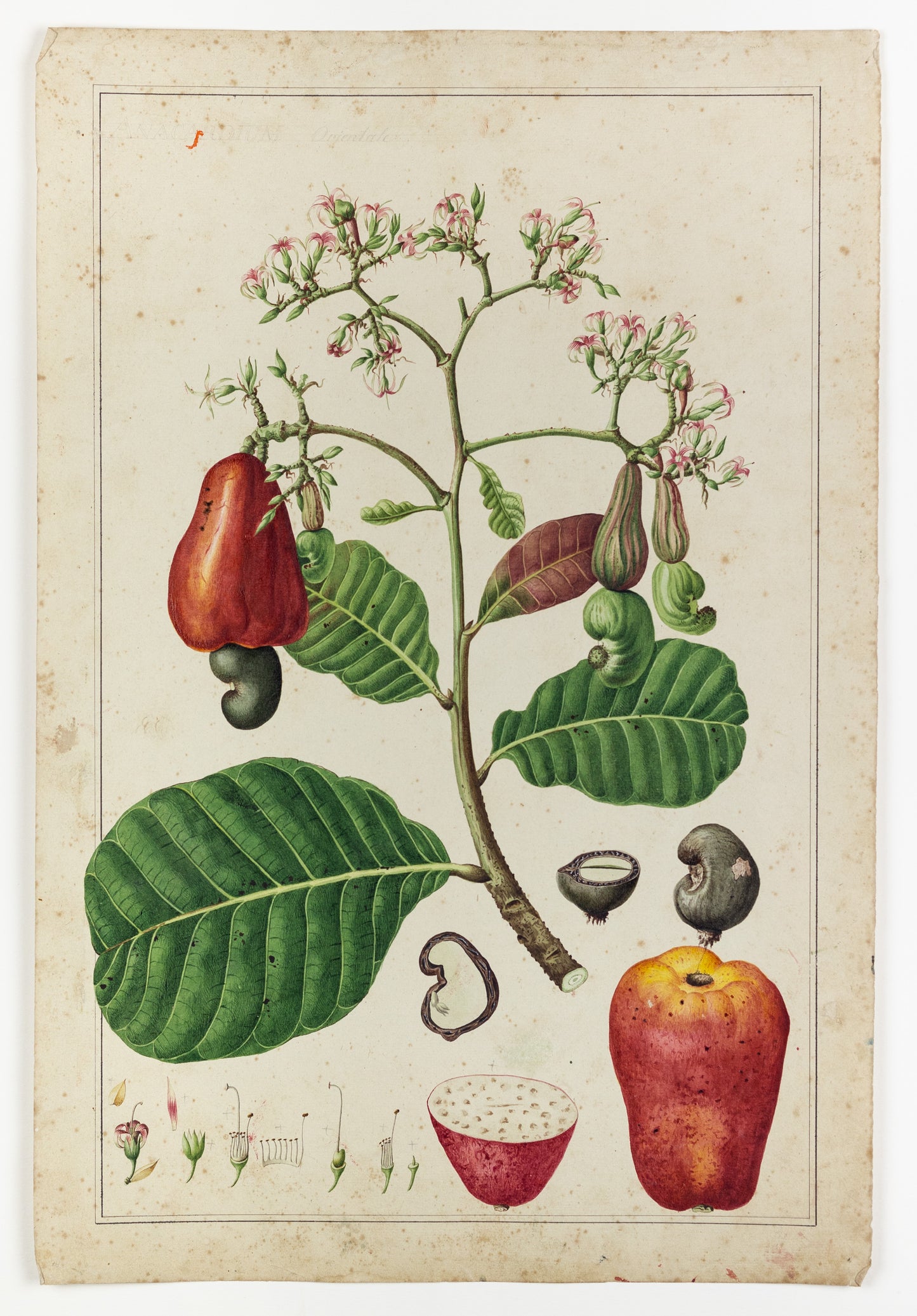from: Poiteau & Turpin Superb Botanical Drawings including varieties from the West Indies
PIERRE JEAN FRANÇOIS TURPIN (FRENCH, 1775 - 1840). Cashew Apple Tree.
PIERRE JEAN FRANÇOIS TURPIN (FRENCH, 1775 - 1840). Cashew Apple Tree.
Couldn't load pickup availability
PIERRE JEAN FRANÇOIS TURPIN (FRENCH, 1775 - 1840)
“Cassuvium Pomiferum. Anacardium Occidentale or the Cashew Apple Tree”
Preparatory drawing for F.R. Tussac. Flore des Antilles, ou histoire générale botanique, rurale et economique des végétaux indigènes des Antilles.
Paris: chez l’auteur, F. Schoell et Hautel, 1808-1827 Vol. 3 Pl. 13
Watercolor and pencil on paper
Paper size: 17 1/8 x 11 3/8 in. Frame size: 24 1/2 x 18 in.
The English name of the cashew nut is derived from the Portuguese name for the fruit of the cashew tree, which is ‘caju’ or ‘acaju’. The word itself comes from the Tupi language and means “nut that produces itself”. Cashew trees are native to tropical South America and were later introduced to other parts of the world by Portuguese explorers in the 1500s.
Tussac wrote of this tree:
“The apple cashew (commonly called mahogany apple in the West Indies) is said to originate from the East Indies; it is found in all the gardens, of which it adorns with the plumes of pretty crimson-colored flowers which end its branches, and with the dazzling red color of the monstrous peduncles which have the shape and size of medium pears or apples, which bear the fruits which we call cashew. These peduncles, which are called apples, have a reputation well above their real value among Creole ladies, and especially children; to eat them with a little pleasure, you have to harvest them at their maturity; if procured too early, they have a bitter juice which catches the throat and irritates the teeth; when they are well ripe, they contain an abundant, vinous juice, which refreshes the mouth and quenches thirst; but we must be careful not to overdo it, we would soon notice a very uncomfortable heaviness in the stomach. One of the most pleasant and healthiest ways to eat them is to cut them into quarters and make a semi-sweet compote. We can extract by expression, from this type of fruit, a juice which, after having fermented, produces a very pleasant little wine, but which only keeps for a few days; otherwise, it becomes a vinegar that can be used, but which is weak. There are several varieties of cashew apples, some red, others yellow, and others white.
The most important product of this tree is the fruit called cashew nut; it has the shape of a kidney; its bark, gray and quite thick, contains a very caustic oil, and contains an almond of a very pleasant taste, from which a sweet oil can be extracted by pressing, very good to eat; to have this almond without exposing yourself to having your hands stained in a way that is very difficult to remove, you throw the nuts into the fire, and leave them there until the caustic oil is completely burned, which is easy to remove… One of the best ways to eat cashew kernels is to pick them while they are still green and tender, and cut them into kernels; for this purpose, they are opened in water to avoid the spillage of the oil that the envelope may already contain. In France, you can even eat cashew kernels by soaking them in lukewarm earth for a while, which makes them swell and become more tender. Cashew nuts or kernels, roasted and prepared like cocoa kernels, make very good chocolate. The oil contained in the shell contains the cashew kernel is so caustic that it is very difficult to get rid of treat stains, either on linen or on the skin; someone who had been imprudent enough to try to open a nut with his mouth had an inflammation even in his throat, from which it was difficult to cure.”

Appeared in F.R. Tussac. Flore des Antilles, ou histoire générale botanique, rurale et economique des végétaux indigènes des Antilles.
Paris: chez l’auteur, F. Schoell et Hautel, 1808-1827 Vol. 3 Pl. 13


